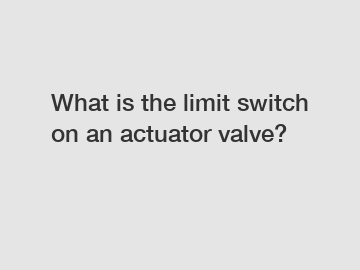Dec. 01, 2023
Electrical Equipment
What is the limit switch on an actuator valve?
The limit switch on an actuator valve is a crucial component that helps control the movement and positioning of the valve. It serves as a feedback mechanism to indicate the valve's open or closed position, providing valuable information to the control system. Let's explore the origins, the process of its functionality, and the significance and impact it has in various applications.
The limit switch was first introduced in the early 20th century when pneumatic and electric actuators started becoming popular. Engineers realized the importance of having a mechanism that could detect and communicate the valve's position accurately. This led to the development of the limit switch, which has since become an integral part of actuator valves in various industries.

The functionality of the limit switch is relatively straightforward. It consists of a mechanical lever or arm that is attached to the actuator valve. As the valve moves, the lever gets engaged or disengaged by a cam or other actuator components. This action triggers the switch, which then sends a signal to the control system, indicating whether the valve is open or closed.
The limit switch is often equipped with an adjustable cam or other mechanisms to fine-tune the actuator's operation. This allows for precise positioning and control of the valve within predetermined limits. By customizing the switch settings, operators can set specific actuation points and optimize valve performance for different applications.
Further reading:The significance of the limit switch lies in its ability to provide accurate feedback to the control system. It ensures that the valve operates within its desired range, preventing overextension or inadequate closure. This not only ensures the optimal functioning of the valve but also safeguards the overall system from potential damage.
In industrial applications, the limit switch plays a vital role in achieving process control and automation. By continuously monitoring the valve's position, operators can take necessary actions to maintain system stability and respond to any deviations promptly. This enhances operational efficiency, reduces downtime, and improves safety.
In addition to industrial applications, the limit switch is also widely used in heating, ventilation, and air conditioning (HVAC) systems, automotive manufacturing, and water treatment processes, among others. Its versatility and reliability make it a key component in various mechanical systems, enabling precise control and ensuring consistent performance.
In conclusion, the limit switch on an actuator valve is a fundamental component that provides essential feedback on the valve's position. Developed in the early 20th century, it has become an integral part of actuator valves, contributing to their reliable and precise operation. By accurately indicating the valve's open or closed status, the limit switch enables effective process control, enhances system performance, and ensures the safety of industrial and mechanical applications.
If you want to learn more, please visit our website Cheap Industrial Limit Switch Supply, Is Limit Switch a Sensor?, Stainless Steel Roller Limit Switch.
Further reading:Related Articles
If you are interested in sending in a Guest Blogger Submission,welcome to write for us!
All Comments ( 0 )